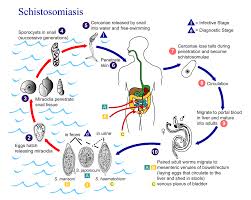Schistosomiasis is a parasitic disease caused by schistosoma.There are various species of schistosoma known as,
- Schistosoma mansoni
- Schistosoma japonicum
- Schistosoma haematobium

Schistosomiasis is also famous as snail fever or bilharzia.
Transmission:
Transmission in humans take either via penetration of skin by free swimming cercariae of schistosomes.The parasites are released by infected snails ,that’s why its also known as snail fever.

Clinical findings:
Many people are asymptotic but chronic infections may become symptomatic.
Acute stage:
It begins shortly after cercarial penetration.
Within twelve hours of infection, an individual may complain of a tingling sensation or light rash, commonly referred to as “swimmer’s itch”, due to irritation at the point of entrance. The rash that may develop can mimic scabies and other types of rashes.
Followed 2-3 weeks later by,
- Fever
- Chills
- Diarrhoea
- Lymphadenopathy
- Hepatosplenomegaly
- Eosinophilia
Chronic stage:
This stage can cause significant morbidity and mortality.
- S.mansoni or S.japonicum causes infection of gastrointestinal tract.These include
- Gastrointestinal hemorrhage
- Hepatomegaly
- Splenomegaly
- Exanguination from ruptured esophageal varices
- S.haematobium causes urinary tract infections and can cause hematuria. The classic sign of urogenital schistosomiasis is haematuria (blood in urine).
Complications:
- Fibrosis of the bladder and ureter, and kidney damage are sometimes diagnosed in advanced cases.
- Bladder cancer is another possible complication in the later stages.
- In women, urogenital schistosomiasis may present with genital lesions, vaginal bleeding, pain during sexual intercourse, and nodules in the vulva.
- In men, urogenital schistosomiasis can induce pathology of the seminal vesicles, prostate, and other organs.
- This disease may also have other long-term irreversible consequences, including infertility.
Prevention and control:
The control of schistosomiasis is based on large-scale treatment of at-risk population groups, access to safe water, improved sanitation, hygiene education, and snail control.
Groups targeted for treatment are:
- School-aged children in endemic areas.
- Adults considered to be at risk in endemic areas, and people with occupations involving contact with infested water, such as fishermen, farmers, irrigation workers, and women whose domestic tasks bring them in contact with infested water.
- Entire communities living in highly endemic areas.
Treatment:
Praziqunatel is the treatment of choice for all three species.






